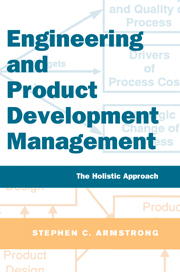Book contents
- Frontmatter
- Contents
- List of figures and tables
- Forewords
- Preface
- Acknowledgments
- Layout of book at a glance
- PART 1 UNDERSTANDING ENGINEERING PROCESS MANAGEMENT
- 1 The holistic approach to managing engineering operations
- 2 An overview of engineering process management
- 3 Organization of engineering tasks
- PART 2 APPLYING ENGINEERING PROCESSES TO PROGRAM MANAGEMENT
- PART 3 DEPLOYING ENGINEERING PROCESS MANAGEMENT
- PART 4 APPENDIXES
- Glossary
- References
- Index
3 - Organization of engineering tasks
Published online by Cambridge University Press: 05 April 2014
- Frontmatter
- Contents
- List of figures and tables
- Forewords
- Preface
- Acknowledgments
- Layout of book at a glance
- PART 1 UNDERSTANDING ENGINEERING PROCESS MANAGEMENT
- 1 The holistic approach to managing engineering operations
- 2 An overview of engineering process management
- 3 Organization of engineering tasks
- PART 2 APPLYING ENGINEERING PROCESSES TO PROGRAM MANAGEMENT
- PART 3 DEPLOYING ENGINEERING PROCESS MANAGEMENT
- PART 4 APPENDIXES
- Glossary
- References
- Index
Summary
This chapter explains the organization of tasks using workplan templates within the task guidelines (see Section 6.2). Within this structure, you will be able to see how a task fits with your program plan and to know how to find detailed information about it.
Tasks depend upon two other elements – resources and schedule. Understanding the resources required to perform a task and the schedule within which the task must fit allows us to manage costs effectively. All three elements must be managed in concert with one another. A change in one element has an impact on the others. Prior to a formal process management, these elements, in many organizations, were managed independently. This imbalance would lead frequently to internal power struggles. Functional directors would assign resources as they saw fit without a view of the impact on other tasks within the integrated master schedule.
Tasks are always organized into the processes that define the business process framework, and processes overlap phases. In addition, developing reference manuals that capture the knowledge you gained on previous programs and that document new or established approaches offers tremendous benefits. They describe the worksteps of howto carry out a task, including technical rules. The documentation of these rules allows the organization to “learn.” The process of maintaining design rules lends itself well to intranet application because it allows distributed access to all members of the collaborative project. Further, an intranet permits ease of update and version control. (See Chapter 11 on utilizing product data management.)
- Type
- Chapter
- Information
- Engineering and Product Development ManagementThe Holistic Approach, pp. 42 - 48Publisher: Cambridge University PressPrint publication year: 2001



